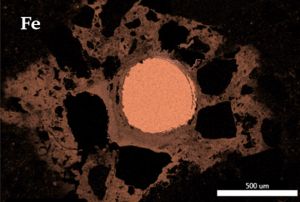The kinetic competition between transport and oxidation of ferrous ions governs precipitation of corrosion products in carbonated concrete
DOI:
https://doi.org/10.21809/rilemtechlett.2018.57Abstract
Corrosion products, originating from steel corrosion and precipitating in the concrete pore system, can lead to concrete cracking and to spalling of the concrete cover. Related premature structural repair causes high costs. Thus, reliable quantitative models are needed, which currently do not exist. Here, we present a new conceptual model to describe the fate of ferrous ions that are released at the steel surface during the corrosion process. The key novelty of our approach can be found in explicitly considering the kinetics of oxidation and transport of Fe2+ in the pore solution. These two processes constantly dilute the Fe2+ concentration and are in competition with the supply of Fe2+ from the anodic iron dissolution reaction. We use a numerical model to elucidate which of the described processes is the fastest. The results find good agreement with experimental data and reveal that under natural corrosion conditions, Fe2+ hardly reach the saturation level, which permits the diffusion of corrosion products up to millimeters away from the steel without necessarily leading to expansive stresses. Under accelerated corrosion conditions, however, precipitation is forced immediately at the steel surface. This fundamentally changes the cracking mechanism and questions the relevance of such tests and related models.

Downloads
Published
How to Cite
Issue
Section
License
Authors retain copyright of the articles published in RILEM Technical Letters and grant the journal the right of first publication with open access. The work is simultaneously licensed under Creative Commons Attribution 4.0 International License (CC BY 4.0) that allows others to share and adapt the work under the following terms: 1) a proper attribution is given in a form of bibliographic record with the DOI link directing to RILEM Technical Letters; 2) a link to the license is provided; 3) the changes (if any) are indicated.









